 |
Home | Charity | Feedback |
Italy:
Bellagio,
Bolzano,
Burano,
Como,
Dolomites,
Florence,
Italian Riviera,
Lake Como,
Menaggio,
Monterosso,
Murano,
Ortisei,
Passo Falzarego,
Pisa,
Portofino,
Riomaggiore,
San Gimignano,
Santa Margherita Ligure,
Selva di Val Gardena,
Varenna,
Venice,
Verona,
Villa Carlotta
Verona, Italy: Love beckons by Prakash Bang, Editor in Chief 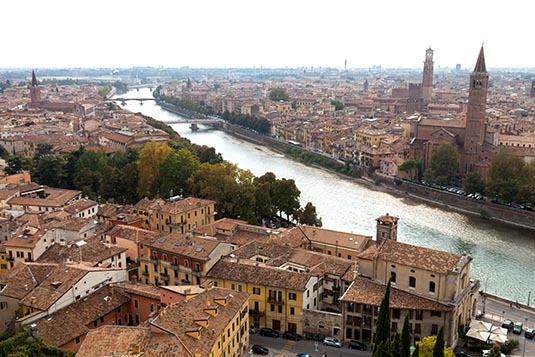 Celebrated by Shakespeare, who made it famous as the romantic setting for the moving tale of Romeo and Juliet, Verona is a splendid, ancient corner of the Veneto region, nestling between the river Adige and Lake Garda, and intimately linked to their waters. 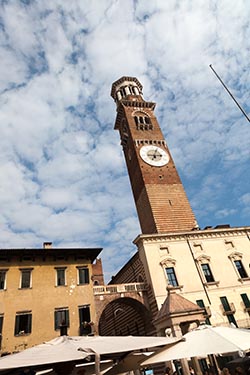 The area was already inhabited in prehistoric times, but who the first people were to establish themselves there remains a mystery. In 89 BC, when it became a Roman Colony, the city began to stand out. Already in ancient times Verona was linked to the river as an essential route for traffic and commerce and it was not by chance that the Romans, who well understood where best to found their cities, established themselves there. The traces of the Romans' works remain very much in evidence to this day.
The area was already inhabited in prehistoric times, but who the first people were to establish themselves there remains a mystery. In 89 BC, when it became a Roman Colony, the city began to stand out. Already in ancient times Verona was linked to the river as an essential route for traffic and commerce and it was not by chance that the Romans, who well understood where best to found their cities, established themselves there. The traces of the Romans' works remain very much in evidence to this day.
From the Middle Ages onwards Verona, more than all the other small towns of North Italy, was always an important artistic centre with a flourishing school of painters. In 1136 it too became a free Commune town and, when decay was inescapable, the Signoria Scaligera (rule of the Scaligera family) established itself. The new rulers dedicated themselves to reorganising the whole town, changing its layout. We were based in Mestre, Venice. Verona was about an hour’s drive from our hotel. After breakfast, we planned a day trip to explore Verona. We parked our car at the lot near Verona railway station. The station is one of the stops of the ‘hop on hop off’ city sight-seeing buses. 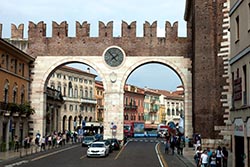 The bus offers 2 lines. Red (Line A) and blue (Line B). A combined ticket for the two lines cost Euro 20 each. Each route trip lasts for about an hour with 8 scheduled stops on the red line and 9 on the blue line.
The bus offers 2 lines. Red (Line A) and blue (Line B). A combined ticket for the two lines cost Euro 20 each. Each route trip lasts for about an hour with 8 scheduled stops on the red line and 9 on the blue line.
Few highlights on Line A. The Basilica di San Zeno (also known as San Zeno Maggiore or San Zenone) is a minor basilica of Verona. Its fame rests partly on its architecture and partly upon the tradition that its crypt was the place of the marriage of Shakespeare's Romeo and Juliet. Together with the abbey which forms an annex, it is dedicated to St. Zeno of Verona. 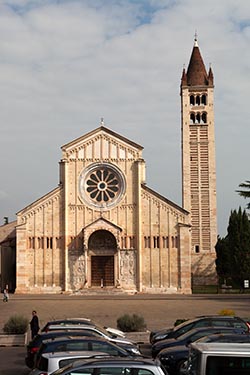 Castelvecchio is a castle in Verona, northern Italy. It is the most important military construction of the Scaliger dynasty that ruled the city in the Middle Ages. It houses the Castelvecchio Museum. Restoration by the architect Carlo Scarpa, between 1959 and 1973, has enhanced the appearance of the building and exhibits. Scarpa's unique architectural style is visible in the details for doorways, staircases, furnishings, and even fixtures designed to hold a specific piece of artwork. The museum displays a collection of sculpture, statues, paintings, ancient weapons, ceramics, gold works, miniatures and some old bells.
Castelvecchio is a castle in Verona, northern Italy. It is the most important military construction of the Scaliger dynasty that ruled the city in the Middle Ages. It houses the Castelvecchio Museum. Restoration by the architect Carlo Scarpa, between 1959 and 1973, has enhanced the appearance of the building and exhibits. Scarpa's unique architectural style is visible in the details for doorways, staircases, furnishings, and even fixtures designed to hold a specific piece of artwork. The museum displays a collection of sculpture, statues, paintings, ancient weapons, ceramics, gold works, miniatures and some old bells.
The Arena of Verona was built by the Romans in the 1st century AD, in the Augustan period. Its name comes from its central area, which was covered with sand, precisely arena in Latin. As in all amphitheatres, the famous gladiator fights were held here, as too were the hunts of fierce exotic animals. The Arena was included in the walls only through the work of the Emperor Gallienus in the 3rd century, as happened elsewhere at the time of the barbaric invasions, when the imposing spectacle buildings were included in the city walls to strengthen them and, while they lost their ancient splendour and the function for which they had been built, they nevertheless became an irreplaceable element for defence. 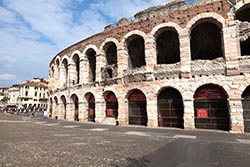 The Arena, as it stands today, is the result of the constant removal of materials, but also of the terrible earthquake that struck the city in the 12th century leaving indelible traces on the monument. Only four arches are left of the outer circle, which was the real, utterly sumptuous, façade.
The Arena, as it stands today, is the result of the constant removal of materials, but also of the terrible earthquake that struck the city in the 12th century leaving indelible traces on the monument. Only four arches are left of the outer circle, which was the real, utterly sumptuous, façade.
The bus terminal is at Piazza Bar. It’s here where we changed from the red to the blue line. Few highlights of this route. Piazza Bra, often shortened to Bra, is the largest piazza in Verona with some claims that it is the largest in Italy. The piazza is lined with numerous cafés and restaurants, along with several notable buildings - the Verona Arena, the town hall and the Palazzo Barbieri. We had an hour on hand between buses, which we spent in the Piazza and the streets around. 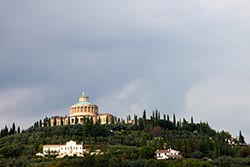 The Roman theatre of Verona (Teatro Romano di Verona) is an ancient Roman theatre and is not to be confused with the Roman amphitheatre known as the Verona Arena. The theatre was built in the late 1st century BC. Before its construction, two walls were built alongside the Adige River, between the Ponte di Pietra and the Ponte Postumio, to protect it against floods. Today only remains of the edifice are visible, recovered starting from around 1830. They include the cavea and the steps, several arcades of the loggias and remains of the stage.
The Roman theatre of Verona (Teatro Romano di Verona) is an ancient Roman theatre and is not to be confused with the Roman amphitheatre known as the Verona Arena. The theatre was built in the late 1st century BC. Before its construction, two walls were built alongside the Adige River, between the Ponte di Pietra and the Ponte Postumio, to protect it against floods. Today only remains of the edifice are visible, recovered starting from around 1830. They include the cavea and the steps, several arcades of the loggias and remains of the stage.
Castle San Pietro is located on a hill in a strategic position. It was inhabited since Roman times of Verona and continued to be inhabited during the barbarian invasions from Alboino and Rosamund, by Pepin, by Berengar, King of Italy. On the ruins of the fortress built by Berengar between the end of the century IX and the beginning of X, and at the old Romanesque church of San Pietro in Castello - which gave its name to the hill - Giangaleazzo Visconti built Castel San Pietro in 1398. 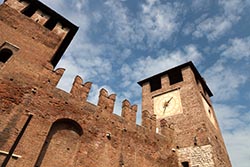 The building dominated from Verona and lasted just over four hundred years: it was blown up in 1801 by French soldiers - after the Treaty of Luneville - abandoned the left of the Adige to retire in the right. Finally, in 1840, the Austrians demolished the remains of the Visconti castle, together with the church. On the area of the castle, the Austrians began in 1851 the construction of barracks-fortress which is still visible: the work was completed in 1856.
The building dominated from Verona and lasted just over four hundred years: it was blown up in 1801 by French soldiers - after the Treaty of Luneville - abandoned the left of the Adige to retire in the right. Finally, in 1840, the Austrians demolished the remains of the Visconti castle, together with the church. On the area of the castle, the Austrians began in 1851 the construction of barracks-fortress which is still visible: the work was completed in 1856.
Property of the City of Verona since 1932, the building is not open to the public, because it ruined by time and neglect of men. The site is popular: from the esplanade in front, overlooking the Roman Theatre and the Stone Bridge, one can enjoy a magnificent view of the city. The bus stops for 5-minutes for taking pictures. 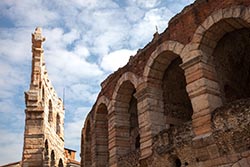 Piazza Duomo location of the Verona Cathedral, a relatively modest structure, was consecrated by St. Zeno by 380 AD on a site just north of the present cathedral. This was replaced by a larger building in the 5th century. Mosaic pavements from these ancient churches can still be seen beneath the Church of St. Elena and the Canons' Cloister. The second basilica was destroyed by earthquake or fire in the 7th century and rebuilt on the present site in the 8th and 9th centuries. This cathedral was destroyed by an earthquake in 1117, and rebuilding work began again.
Piazza Duomo location of the Verona Cathedral, a relatively modest structure, was consecrated by St. Zeno by 380 AD on a site just north of the present cathedral. This was replaced by a larger building in the 5th century. Mosaic pavements from these ancient churches can still be seen beneath the Church of St. Elena and the Canons' Cloister. The second basilica was destroyed by earthquake or fire in the 7th century and rebuilt on the present site in the 8th and 9th centuries. This cathedral was destroyed by an earthquake in 1117, and rebuilding work began again.
The northern side of the square is occupied by the ancient town hall, the Torre dei Lamberti, the Casa dei Giudici ("Judges' Hall") and the frescoed Mazzanti Houses. The western side, the shortest one, features the Baroque Palazzo Maffei, decorated by statues of Greek gods. It is faced by a white marble column, on which is Saint Mark's Lion, symbol of the Republic of Venice. 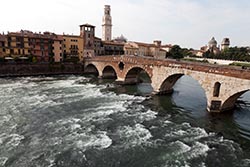 The present cathedral of Verona was built in 1117-38, but many renovations were made later. The interior was completely remodeled in the Gothic style in the 15th and 16th centuries. Restoration of frescoes, wooden furnishings and the lighting system was completed in 2002. The square's most ancient monument is the fountain (built in 1368 by Cansignorio della Scala), surmounted by a statue called Madonna Verona, which is however a Roman sculpture dating to 380 AD.
The present cathedral of Verona was built in 1117-38, but many renovations were made later. The interior was completely remodeled in the Gothic style in the 15th and 16th centuries. Restoration of frescoes, wooden furnishings and the lighting system was completed in 2002. The square's most ancient monument is the fountain (built in 1368 by Cansignorio della Scala), surmounted by a statue called Madonna Verona, which is however a Roman sculpture dating to 380 AD.
Back at the bus terminal at about 5 PM, we took a cab to the parking lot and began our drive to our hotel in Mestre. Next morning we would leave for Florence. Verona Image Gallery  Photo viewer Photo viewer
|
|
|
Home |
Charity |
Feedback
Privacy Policy | Terms of Usage © YoGoYo.com. All rights reserved. |



































